MOTION AND MEASUREMENT OF DISTANCES for Class 6 SCIENCE
Introduction
Jaisa ki hamare chapter ka name hai “Motion and measurement of distances” toh iss chapter mein hum motion ke baare mein padhenge ki motion kya hota hai, log ya koi bhi object kaise move karta hai. Iss chapter mein hum transport ki poori story ke baare mein padhenge ki pehle log kaise travel karte the, fir kya huva, kya kya new discoveries huyi, etc. Hum yaha motion ke types ke baare mein bhi janege ki kaise different objects different types ke motion show karte hai. Fir hum measurement ke baare mein bhi padhenge aur jaanege ki kaise kisi object ki length ya fir kisi distance ko measure kiya ja sakta hai aur koi bhi length ya distance measure karte huve hamein kin chijo ka dhyan rakhna chahiye.
Story of Transport
Pehle ke time mein logo ke paas travel karne ke liye ya fir samaan le jaane ke liye koi transport nahi hote the woh walk karte the aur back par saman carry karte the lekin baad mein unhone bahut saare aise means of transport discover kiye jisse unka kahi bhi aana-jaana aur saaman le jana bahut easy ho gaya.
Logo ne water routes se transport ke liye boat discover ki, fir wheel ka invention huva, animals ko wheel wali carts ko move karne ke liye use kiya jaane laga. Iske bad steam engine invent huva jisse new means of transport develop huve. Steam engine driven carriages and wagons ke liye railroads banaye gaye. Uske baad automobiles jaise car, truck, etc. discover huve. Water mein bhi motorised boats aur ships use hone lagi.
Early 1900 mein aeroplane ki development hui aur baad mein yeh passengers aur goods ko bhi carry karne lage.
20th century mein electric trains, monorails, supersonic aeroplanes, etc. aaye.
How Wide Is This Desk?
Ab transport toh discover ho gaya lekin hamein yeh kaise pata chalega ki agar hamein kahi jana hai toh hamein kounsa transport use karna chahiye?Iske liye hamein sabse pehle yeh janna jaruri hai ki hamein kitni door jana hai ya hamein kitna distance travel karna hai. Aur iske liye hamein uss distance ko measure karna hoga. Lekin hum uss distance ko measure kaise karenge?
Iss distance ko measure karne ke liye kafi ways use kiye jaate hai-
Non-standard Measures: Non-standard measures mein hum steps, arms, hands ya fingers se length measure karte hai lekin different people ke arms, hands, etc. ke different measurement hote hai isliye yeh koi bhi distance measure karne ke liye reliable nahi hote. Inko non-standard measures kehte hai. Kisi bhi object ya distance ki correct measurement kaise ki jayegi yeh hum issi chapter mein aage padhenge.
Some Measurements
Measurement kya hota hai?
Measurement ka matlab hai ek unknown quantity ka kisi known quantity ke saath comparison karna. Jis known quantity ke saath hum unknown quantity ko compare karte hai usko hum unit kehte hai.
Kisi bhi thing ka agar hum measurement karte hai toh usko do parts mein express kiya jata hai- number aur unit of measurement.
Eg- Agar hum kisi room ki length measure karte hai aur uski length hamare foots ki 12 lengths ke equal aati hai that means 12 number hai aur foot unit of measurement hai.
Lekin agar hum apne foot ya handspan se koi distance ya length measure karte hai toh har ek person ke liye same distance vary karega kyonki sabke handspan, foot, etc. ka size different hota hai, toh iske liye hamein measurement ka koi aisa system chahiye jo person to person change na ho aur worldwide accepted ho.
Standard Units Of Measurements
Jaisa ki hamne padha ki ancient time mein log foot, angul, arms, etc. se different distances ko measure karte the isliye bahut confusion hoti thi.1790 mein french ne measurement ki ek standard unit create ki jisko hum metric system kehte hai. Issi tarah all over the world scientists ne kuchh sets of standard units ko accept kiya. Aaj jo system of units use kiya jata hai usko international system of units ya SI units kehte hai.
Eg- Length ki SI unit metre hoti hai. Isko hum (m) se denote karte hai. Each metre 100 equal divisions mein divided hai jisko hum centimetre (cm) kehte hai.aureach centimetre ten equal divisions mein divided hai jisko hum millimetre (mm) kehte hai.
1 m = 100 cm
1 cm = 10 mm
Correct Measurement Of Length
Daily life mein hum different things ko measure karne ke liye different devices ka use karte hai. Eg- Tailor measurement ke liye tape use karta hai, cloth merchant cloth measure karne ke liye metre rod use karta hai.
Hamein measurement ke liye suitable device use karna chahiye. Ab hum sikhte hai ki measure kaise kiya jata hai aur kisi bhi object ki length measure karte huve hamein kya kya dhyan rakhna chahiye.
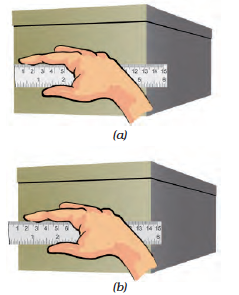
Measuring The Length Of A Curved Line
Hum kisi bhi curved line ki length ko directly scale se measure nahi kar sakte, hum thread ki help se usko measure kar sakte hai.
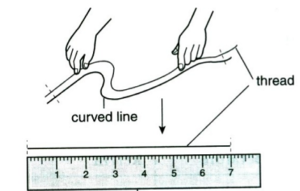
Steps to measure length of a curved line-
Moving Things Around Us
Hamare aas-paas jitni bhi things hai, jitne bhi objects hai kuchh stationary rehte hai, kuchh continuously movement show karte rehte hai. Eg- Hum apne aas-pas house, table clock, etc. dekhte hai jo move nahi karte, matlab yeh stationary objects hai aur flying bird, second hand of clock, aunt, mosquito, etc. yeh continuously movement show karte rehte hai.
Toh ab hum motion ko define kar sakte hai-
Kisi bhi object ki position mein time ke sath change aata hai toh usko motion kehte hai.
Motion bhi different types ke hote hai. Ab hum different motions ke baare mein padhenge.
Types Of Motion
1. Rectilinear Motion: Jab koi bhi object straight line mein move karta hai toh uss motion ko hum rectilinear motion kehte hai. Eg- Motion of a vehicle on a straight road, march past of soldiers in a parade, etc.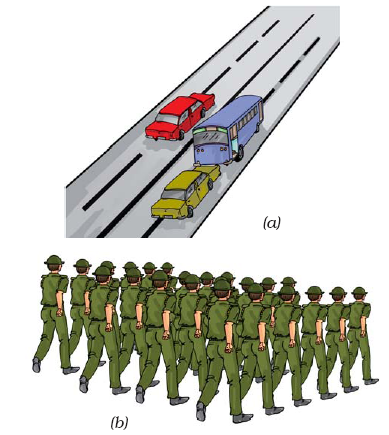
2. Circular Motion: Jab bhi koi body circular path mein move karti hai, usko circular motion kehte hai.Eg- Motion of a point marked on the blade of an electric fan, motion of the hands of a clock, etc. Circular motion mein object ka centre se distance same rehta hai.
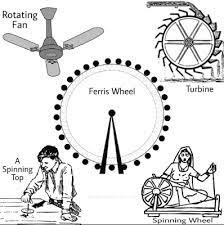
3. Periodic Motion: Aisa motion jisme object apna motion ek fixed interval of time ke baad repeat karta hai usko periodic motion kehte hai. Eg- Motion of a pendulum, branch of tree moving to and fro, motion of a swing, etc.
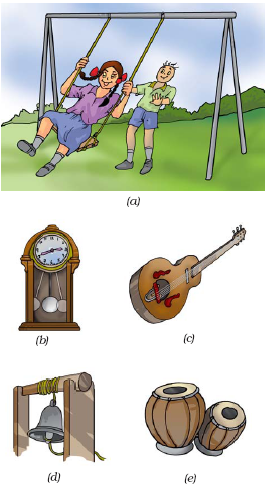
4. Rotational Motion: Aisa motion jisme whole body ek axis par move karti hai, usko rotational motion kehte hai. Eg- Motion of a top (lattu), rotation of earth, etc.

POINT 1
Motion: Motion is the phenomenon in which an object changes its position over time.
Periodic motion: A motion that repeats itself after equal intervals of time is known as periodic motion.
Rectilinear motion: Rectilinear motion is a motion of a particle or object along a straight line.
Circular motion: Circular motion is described as a movement of an object while rotating along a circular path.
Rotational motion: Rotational motion is the motion of a body about a fixed axis.
SI units: The International System of Units is the modern form of the metric system.
SUMMARY
1. Different modes of transport are used to go from one place to another.
2. In ancient times, people used length of a foot, the width of a finger, the distance of a step as units of measurement. This caused confusion and a need to develop a uniform system of measurement arose.
3. Now, we use International System of Units ( SI units). This is accepted all over the world.
4. Metre is the unit of length in SI unit.
5. Motion in a straight line is called rectilinear motion.
6. In circular motion an object moves such that its distance from a fixed point remains the same.
7. Motion that repeats itself after some period of time is called periodic motion.